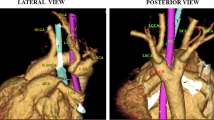Abstract
A right aortic arch occurs in 5% of patients with esophageal atresia. Its presence has significant implications; there is a high association of other anomalies, especially cardiac types. Repair of the atresia has been regarded as difficult with the usual approach through the right chest. We report our experience with five cases of right aortic arch and esophageal atresia treated in the past 5 years. In four cases this association was not recognized preoperatively and the right aortic arch was not an obstacle in repairing the atresia through the standard right thoracotomy. In one case the right aortic arch was diagnosed before surgery; repair was done through the left chest.
Similar content being viewed by others
References
Berdon WE, Baker DH, Schullinger JN, Santulli TV (1979) Plain film detection of right aortic arch in infants with esophageal atresia and tracheoesophageal fistula. J Pediatr Surg 14: 436–437
David TJ, O'Callaghan SE (1974) Cardiovascular malformations and esophageal atresia. Am Heart J 36: 559–563
German JC, Mahour GH, Woolley MM (1976) Esophageal atresia and associated anomalies. J Pediatr Surg 11: 299–304
Haight C, Towsley HA (1943) Congenital atresia of the esophagus with tracheoesophageal fistula. Extrapleural ligation of the fistula and end to end anastomosis of esophageal segments. Surg Gynecol Obstet 76: 672–676
Harrison MR, Hanson BA, Mahour GH, Takahashi M, Weitzman JJ (1977) The significance of right aortic arch in repair of esophageal atresia and tracheoesophageal fistula. J Pediatr Surg 12: 861–869
Knight L, Edwards JE (1974) Right aortic arch. Types and associated anomalies. Circulation 50: 1047–1051
Livaditis A, Radberg L, Odensjo G (1972) Esophageal end to end anastomosis. Reduction of anastomosis tension by circular myotomy. Scand J Thorac Cardiovasc Surg 6: 206–214
Marshall DG (1987) An alternative to an interposition procedure in esophageal atresia. J Pediatr Surg 22: 775–778
Mellins RB, Blumenthol S (1964) Cardiovascular anomalies and esophageal atresia. Am J Dis Child 107: 160–165
Quan L, Smith DW (1973) The Vater association: vertebral defects, anal atresia, tracheoesophageal fistula with esophageal atresia, radial and renal dysplasia. J Pediatr 82: 104–110
Randolph JG (1986) Esophageal atresia and congenital stenosis. In: Welch KJ, Randolph JG, Ravitch MM, O'Neill JA, Rowe MI (eds) Pediatric surgery. Year Book Medical, Chicago, pp 682–693
Shafer AD, David TE (1974) Suture fistula as a means of connecting upper and lower segments in esophageal atresia. J Pediatr Surg 9: 669–673
Weigel W, Kaufmann HJ (1976) The frequency and type of other congenital anomalies in association with tracheoesophageal malformations. Clin Pediatr 15: 819–834
Author information
Authors and Affiliations
Additional information
Offprint requests to: G. Stringel
Rights and permissions
About this article
Cite this article
Stringel, G., Coln, D. & Guertin, L. Esophageal atresia and right aortic arch. Pediatr Surg Int 5, 103–105 (1990). https://doi.org/10.1007/BF00178226
Accepted:
Issue Date:
DOI: https://doi.org/10.1007/BF00178226




